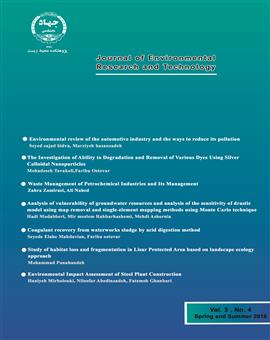Study of habitat loss and fragmentation in Lisar Protected Area based on landscape ecology approach
Subject Areas : Ecosystem sustainability
1 - عضو هیات علمی
Keywords: Landscape metric habitat loss FragmentationProtected area Lisar ,
Abstract :
Landscape ecology metrics are used to describe composition and configuration of landscapes. The aim of this study was examination of habitat loss and fragmentation in Lisar Protected area in Guilan province during time period of 1990-2015.In this study , using Landsat images(1990-2015), after radiometric and atmospheric correction, three density classes of forest cover(10-40%,40-70% and above 70%) were produced. Reference maps and field study were applied for interpretation of images and maximum likelihood method was used for classification. Using ArcGis and Patch Analyst software, with derived metrics, trend of habitat loss and fragmentation was examined.
1. آذری دهکردی،ف.،خزاعی،ن.1388.سامانه پشتیبان تصمیم گیری سریع برای ارزیابی پیامد فعالیتها در تخریب سیمای سرزمین،حوزه آبخیز شفارود، مجله محیط شناسی،سال سی و پنجم ،شماره51 صص 80-69.
2. زبردست،ل.،یاوری،ا.ر.،صالحی،ا .،مخدوم،م.1390. استفاده از متریک اندازه موثر شبکه در تحلیل از هم گسیختگی پوششهای جنگلی محدوده اثر جاده پارک ملی گلستان، محیط شناسی،سال سی و هفتم،شماره 58 صص20-15.
3. Aguilar R, Quesada M, Ashworth L, Herrerias-Diego Y, and Lobo J .2008. Gen consequences of habitat fragmentation in plant populations: Susceptible signal in plant traits and methodological approaches. Molecular Ecology 17: pp.5177–5188.
4. Andre´n H.1994. Effects of habitat fragmentation on birds in landscapes with different proportions of suitable habitat: A review. Oikos 71:pp. 355–366.
5. Balmford A,BrunerA,CooperP, et al. 2002.Ecology–Economic reasons for conserving wild nature. Science 297:pp. 950–953.
6. Bruijnzeel LA .2004. Hydrological functions of tropical forests: Not seeing the soil for the trees?Agriculture. Ecosystems & Environment 104:pp. 185–228.
7. Ewers RM and Didham RK .2006. Confounding factors in the detection of species responses to habitat fragmentation. Biological Reviews 81:pp. 117–142.
8. Fahrig L .2003. Effects of habitat fragmentation on biodiversity. Annual Review of Ecology, Evolution,and Systematics 34:pp. 487–515.
9. FAO.2003. World Agriculture:Towards2015/2030.AnFAOPerspective. Rome, Italy: Food and Agriculture Organization of the United Nations.
10. FAO.2010. Global Forest Resources Assessment 2010–Key Findings. Rome, Italy: Food and Agriculture Organization of the United Nations.
11. Harrod RJ, McRae BH, and Hartl WE.1999. Historical stand reconstruction in ponderosa pine forests to guide silvicultural prescriptions. Forest Ecology and Management 114: pp.433–446.
12. Laurance WF,LovejoyTE,VasconcelosH. 2002. Ecosystem decay of Amazonian forest fragments:A22-year investigation. Conservation Biology16:pp.606-618.
13. Laurance WF and Useche DC .2009. Environmental synergisms and extinctions o ftropical species. Conservation Biology 23:pp. 1427–1437.
14. Makhdoum,M.F.2002.Degradation Model:A Quantitative EIA Instrument,Acting as a decision
Support System (DSS) for Environmental management, J.Environmental Management 30: pp.151-156.
15. Mahdoum,M.F.2008.Landscape Ecology or Environmental Studies(Land Ecology)(European versus Anglo-Saxon School of Thoughts), International Journal of Environmental Application and Science 3: pp.147-160.
16. N.Lopoukhine,N.Crawhall,N.Dudley,P.Faggis,C.Karibouhoye,D.Laffoley,J.Miranda-Londono, K.Mackinnon and T.Sandwith. Protected Areas: providing natural solutions to 21 st century challenges, S.A.P. I.EN.S [online]. 5.2.2012.Online Since 10 August 2012, connection on 26 December 2015.URL: http://sapiens.revues.og/125.
17. Potts SG, BiesmeijerJC, KremenC. 2010. Global pollinatordeclines: Trends, impacts anddrivers. Trends in Ecology and Evolution 25:pp. 345–353.
18. Ricketts TH, Regetz J,Steffan- Dewenter I. 2008. Landscape effects on crop pollination services:Are there general patterns? Ecology Letters 11:pp. 499–515.


